
Christian cross
Encyclopedia

Crucifixion
Crucifixion is an ancient method of painful execution in which the condemned person is tied or nailed to a large wooden cross and left to hang until dead...
of Jesus Christ, is the best-known religious symbol of Christianity
Christianity
Christianity is a monotheistic religion based on the life and teachings of Jesus as presented in canonical gospels and other New Testament writings...
. It is related to the crucifix
Crucifix
A crucifix is an independent image of Jesus on the cross with a representation of Jesus' body, referred to in English as the corpus , as distinct from a cross with no body....
(a cross that includes a usually three-dimensional representation of Jesus' body) and to the more general family of cross
Cross
A cross is a geometrical figure consisting of two lines or bars perpendicular to each other, dividing one or two of the lines in half. The lines usually run vertically and horizontally; if they run obliquely, the design is technically termed a saltire, although the arms of a saltire need not meet...
symbols.
Pre-Christian crosses
The cross-shaped sign, represented in its simplest form by a crossing of two lines at right angles, greatly antedates, in both East and West, the introduction of Christianity. It goes back to a very remote period of human civilization. It is supposed to have been used not just for its ornamental value, but also with religious significance.Some have sought to attach to the widespread use of this sign, in particular in its swastika
Swastika
The swastika is an equilateral cross with its arms bent at right angles, in either right-facing form in counter clock motion or its mirrored left-facing form in clock motion. Earliest archaeological evidence of swastika-shaped ornaments dates back to the Indus Valley Civilization of Ancient...
form, a real ethnographic importance. It may have represented the apparatus used in kindling fire, and thus as the symbol of sacred fire or as a symbol of the sun, denoting its daily rotation. It has also been interpreted as the mystic representation of lightning
Lightning
Lightning is an atmospheric electrostatic discharge accompanied by thunder, which typically occurs during thunderstorms, and sometimes during volcanic eruptions or dust storms...
or of the god of the tempest, and even the emblem of the Aryan
Aryan
Aryan is an English language loanword derived from Sanskrit ārya and denoting variously*In scholarly usage:**Indo-Iranian languages *in dated usage:**the Indo-European languages more generally and their speakers...
pantheon and the primitive Aryan civilization.
Another symbol that has been connected with the cross is the ansated cross (ankh
Ankh
The ankh , also known as key of life, the key of the Nile or crux ansata, was the ancient Egyptian hieroglyphic character that read "eternal life", a triliteral sign for the consonants ʻ-n-ḫ...
or crux ansata) of the ancient Egyptians, which often appears as a symbolic sign in the hands of the goddess Sekhet, and appears as a hieroglyphic sign of life or of the living. In later times the Egyptian Christians (Copts), attracted by its form, and perhaps by its symbolism, adopted it as the emblem of the cross. In his book, The Worship of the Dead (London, 1904), p. 226, Colonel J. Garnier wrote: "The cross in the form of the 'Crux Ansata'… was carried in the hands of the Egyptian priests and Pontiff kings as the symbol of their authority as priests of the Sun god and was called 'the Sign of Life'."
In the Bronze Age we meet in different parts of Europe a more accurate representation of the cross, as conceived in Christian art, and in this shape it was soon widely diffused. This more precise characterization coincides with a corresponding general change in customs and beliefs. The cross is now met with, in various forms, on many objects: fibulas, cincture
Cincture
The cincture is a liturgical vestment, worn encircling the body around or above the waist. The term has two distinct meanings, the usage generally dividing along denominational lines...
s, earthenware fragments, and on the bottom of drinking vessels. De Mortillet is of opinion that such use of the sign was not merely ornamental, but rather a symbol of consecration, especially in the case of objects pertaining to burial. In the proto-Etruscan cemetery of Golasecca
Golasecca
Golasecca is a town and comune in the province of Varese, Lombardy .It has given its name to the Golasecca culture, a prehistoric civilization who lived in the Ticino River area from the Bronze Age until the 1st century BC....
every tomb has a vase with a cross engraved on it. True crosses of more or less artistic design have been found in Tiryns
Tiryns
Tiryns is a Mycenaean archaeological site in the prefecture of Argolis in the Peloponnese, some kilometres north of Nauplion.-General information:...
, at Mycenæ, in Crete, and on a fibula from Vulci.
Early Christian use
During the first two centuries of Christianity, the cross may have been rare in Christian iconographyIconography
Iconography is the branch of art history which studies the identification, description, and the interpretation of the content of images. The word iconography literally means "image writing", and comes from the Greek "image" and "to write". A secondary meaning is the painting of icons in the...
, as it depicts a purposely painful and gruesome method of public execution and Christians were reluctant to use it. The Ichthys
Ichthys
Ichthys, from Koine Greek: , is the Greek word for "fish"....
, or fish symbol, was used by early Christians. The Chi-Rho monogram, which was adopted by Constantine I
Constantine I
Constantine the Great , also known as Constantine I or Saint Constantine, was Roman Emperor from 306 to 337. Well known for being the first Roman emperor to convert to Christianity, Constantine and co-Emperor Licinius issued the Edict of Milan in 313, which proclaimed religious tolerance of all...
in the 4th century as his banner (see labarum
Labarum
The labarum was a vexillum that displayed the "Chi-Rho" symbol ☧, formed from the first two Greek letters of the word "Christ" — Chi and Rho . It was used by the Roman emperor Constantine I...
), was another Early Christian symbol of wide use.
However, the cross symbol was already associated with Christians in the 2nd century, as is indicated in the anti-Christian arguments cited in the Octavius
Octavius (dialogue)
Octavius is an early writing in defense of Christianity by Marcus Minucius Felix. It is written in the form of a dialogue between the pagan Caecilius Natalis and the Christian Octavius Januarius, a provincial lawyer, the friend and fellow-student of the author....
of Minucius Felix, chapters IX and XXIX, written at the end of that century or the beginning of the next, and by the fact that by the early 3rd century the cross had become so closely associated with Christ that Clement of Alexandria
Clement of Alexandria
Titus Flavius Clemens , known as Clement of Alexandria , was a Christian theologian and the head of the noted Catechetical School of Alexandria. Clement is best remembered as the teacher of Origen...
, who died between 211 and 216, could without fear of ambiguity use the phrase (the Lord's sign) to mean the cross, when he repeated the idea, current as early as the apocrypha
Apocrypha
The term apocrypha is used with various meanings, including "hidden", "esoteric", "spurious", "of questionable authenticity", ancient Chinese "revealed texts and objects" and "Christian texts that are not canonical"....
l Epistle of Barnabas
Epistle of Barnabas
The Epistle of Barnabas is a Greek epistle containing twenty-one chapters, preserved complete in the 4th century Codex Sinaiticus where it appears at the end of the New Testament...
, that the number 318 (in Greek numerals
Greek numerals
Greek numerals are a system of representing numbers using letters of the Greek alphabet. They are also known by the names Ionian numerals, Milesian numerals , Alexandrian numerals, or alphabetic numerals...
, ΤΙΗ) in was interpreted as a foreshadowing (a "type") of the cross (T, an upright with crossbar, standing for 300) and of Jesus (ΙΗ, the first two letter of his name ΙΗΣΟΥΣ, standing for 18), and his contemporary Tertullian
Tertullian
Quintus Septimius Florens Tertullianus, anglicised as Tertullian , was a prolific early Christian author from Carthage in the Roman province of Africa. He is the first Christian author to produce an extensive corpus of Latin Christian literature. He also was a notable early Christian apologist and...
could designate the body of Christian believers as crucis religiosi, i.e. "devotees of the Cross". In his book De Corona, written in 204, Tertullian tells how it was already a tradition for Christians to trace repeatedly on their foreheads the sign of the cross
Sign of the cross
The Sign of the Cross , or crossing oneself, is a ritual hand motion made by members of many branches of Christianity, often accompanied by spoken or mental recitation of a trinitarian formula....
.
The Jewish Encyclopedia
Jewish Encyclopedia
The Jewish Encyclopedia is an encyclopedia originally published in New York between 1901 and 1906 by Funk and Wagnalls. It contained over 15,000 articles in 12 volumes on the history and then-current state of Judaism and the Jews as of 1901...
says:
- The cross as a Christian symbol or "seal" came into use at least as early as the second century (see "Apost. Const." iii. 17; Epistle of Barnabas, xi.-xii.; Justin, "Apologia," i. 55-60; "Dial. cum Tryph." 85-97); and the marking of a cross upon the forehead and the chest was regarded as a talisman against the powers of demons (Tertullian, "De Corona," iii.; Cyprian, "Testimonies," xi. 21–22; Lactantius, "Divinæ Institutiones," iv. 27, and elsewhere). Accordingly the Christian Fathers had to defend themselves, as early as the second century, against the charge of being worshipers of the cross, as may be learned from Tertullian, "Apologia," xii., xvii., and Minucius Felix, "Octavius," xxix. Christians used to swear by the power of the cross (see Apocalypse of Mary, viii., in James, "Texts and Studies," iii. 118).
In contemporary Christianity

Agape
Agape is one of the Greek words translated into English as love, one which became particularly appropriated in Christian theology as the love of God or Christ for mankind. In the New Testament, it refers to the fatherly love of God for humans, as well as the human reciprocal love for God; the term...
in Christ's sacrifice at Calvary—"the Lamb of God who takes away the sin of the world." The cross also reminds Christians of Jesus' victory over sin
Sin
In religion, sin is the violation or deviation of an eternal divine law or standard. The term sin may also refer to the state of having committed such a violation. Christians believe the moral code of conduct is decreed by God In religion, sin (also called peccancy) is the violation or deviation...
and death, since it is believed that through His death and resurrection He conquered death itself. They venerate it not as a material object seen in isolation but as the symbol of the sacrifice by which Christ saved them, as the instrument of Christ's triumph, according to ("Having disarmed the powers and authorities, he made a public spectacle of them, triumphing over them by the cross"), and "as the instrument of our God's saving Love".
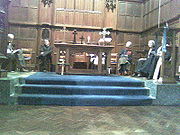
Lutheranism
Lutheranism is a major branch of Western Christianity that identifies with the theology of Martin Luther, a German reformer. Luther's efforts to reform the theology and practice of the church launched the Protestant Reformation...
, some Anglicans, and other Christians often make the Sign of the Cross
Sign of the cross
The Sign of the Cross , or crossing oneself, is a ritual hand motion made by members of many branches of Christianity, often accompanied by spoken or mental recitation of a trinitarian formula....
upon themselves. This was already a common Christian practice in the time of Tertullian
Tertullian
Quintus Septimius Florens Tertullianus, anglicised as Tertullian , was a prolific early Christian author from Carthage in the Roman province of Africa. He is the first Christian author to produce an extensive corpus of Latin Christian literature. He also was a notable early Christian apologist and...
.
The Feast of the Cross
Feast of the Cross
In the Christian liturgical calendar, there are several different Feasts of the Cross, all of which commemorate the cross used in the crucifixion of Jesus....
is an important Christian feast. One of the twelve Great Feasts in Eastern Orthodoxy is the Exaltation of the Cross on September 14, which commemorates the consecration
Consecration
Consecration is the solemn dedication to a special purpose or service, usually religious. The word "consecration" literally means "to associate with the sacred". Persons, places, or things can be consecrated, and the term is used in various ways by different groups...
of the basilica
Basilica
The Latin word basilica , was originally used to describe a Roman public building, usually located in the forum of a Roman town. Public basilicas began to appear in Hellenistic cities in the 2nd century BC.The term was also applied to buildings used for religious purposes...
on the site where the original cross
True Cross
The True Cross is the name for physical remnants which, by a Christian tradition, are believed to be from the cross upon which Jesus was crucified.According to post-Nicene historians, Socrates Scholasticus and others, the Empress Helena The True Cross is the name for physical remnants which, by a...
of Jesus was reportedly discovered in 326 by Helena of Constantinople
Helena of Constantinople
Saint Helena also known as Saint Helen, Helena Augusta or Helena of Constantinople was the consort of Emperor Constantius, and the mother of Emperor Constantine I...
, mother of Constantine the Great. The Catholic Church celebrates the feast on the same day and under the same name (In Exaltatione Sanctae Crucis), though in English it has been called the feast of the Triumph of the Cross.
Roman Catholic, Eastern Orthodox and Anglican bishop
Bishop
A bishop is an ordained or consecrated member of the Christian clergy who is generally entrusted with a position of authority and oversight. Within the Catholic Church, Eastern Orthodox, Oriental Orthodox Churches, in the Assyrian Church of the East, in the Independent Catholic Churches, and in the...
s place a cross [+] before their name when signing
Signature
A signature is a handwritten depiction of someone's name, nickname, or even a simple "X" that a person writes on documents as a proof of identity and intent. The writer of a signature is a signatory. Similar to a handwritten signature, a signature work describes the work as readily identifying...
a document. A cross [†] may also be placed before the name of a departed Christian when their name appears in print.
Exclusion

Jehovah's Witnesses
Jehovah's Witnesses is a millenarian restorationist Christian denomination with nontrinitarian beliefs distinct from mainstream Christianity. The religion reports worldwide membership of over 7 million adherents involved in evangelism, convention attendance of over 12 million, and annual...
do not accept the use of the cross as a symbol of Christianity. They claim that there no Biblical support for doing so and regard it as idolatry
Idolatry
Idolatry is a pejorative term for the worship of an idol, a physical object such as a cult image, as a god, or practices believed to verge on worship, such as giving undue honour and regard to created forms other than God. In all the Abrahamic religions idolatry is strongly forbidden, although...
. They believe that the cross was widely used by worshipers of Tammuz, a Babylonian god, as his symbol. They believe that Jesus died, not on a two-beam cross, but on an upright stake, in accordance with the interpretation of the Greek word σταυρός (stauros
Stauros
Stauros is the Greek word, usually translated cross, that in the Bible is used in reference to the device on which Jesus was executed...
). In classical Greek, this word meant merely an upright stake, or pale. Later it also came to be used for an execution stake having a crosspiece. Although formerly, the Watchtower Society's publications had stated that Christ was crucified on a cross.
Members of the Church of Jesus Christ of Latter Day Saints
Mormonism
Mormonism is the religion practiced by Mormons, and is the predominant religious tradition of the Latter Day Saint movement. This movement was founded by Joseph Smith, Jr. beginning in the 1820s as a form of Christian primitivism. During the 1830s and 1840s, Mormonism gradually distinguished itself...
believe that Jesus died on a cross, however "For us the cross is the symbol of the dying Christ, while our message is a declaration of the living Christ... the lives of our people must become the only meaningful expression of our faith and, in fact, therefore, the symbol of our worship." Latter Day Saints do not place the cross on their buildings because the Bible does not mention the cross as a symbol for Christianity. Most temples will usually decorate one spire of the temple with a symbol of the Angel Moroni as an expression that the heavens have been reopened to man on earth.
Forms of the Cross
The cross is often shown in different shapes and sizes, in many different styles. It may be used in personal jewelry, or used on top of church buildings. It is shown both empty and in crucifixCrucifix
A crucifix is an independent image of Jesus on the cross with a representation of Jesus' body, referred to in English as the corpus , as distinct from a cross with no body....
form, that is, with a figure of Christ, often referred to as the corpus (Latin
Latin
Latin is an Italic language originally spoken in Latium and Ancient Rome. It, along with most European languages, is a descendant of the ancient Proto-Indo-European language. Although it is considered a dead language, a number of scholars and members of the Christian clergy speak it fluently, and...
for "body"), affixed to it. Roman Catholic
Roman Catholic Church
The Catholic Church, also known as the Roman Catholic Church, is the world's largest Christian church, with over a billion members. Led by the Pope, it defines its mission as spreading the gospel of Jesus Christ, administering the sacraments and exercising charity...
, Anglican and Lutheran depictions of the cross are often crucifixes, in order to emphasize that it is Jesus that is important, rather than the cross in isolation. Large crucifixes are a prominent feature of some Lutheran churches, as illustrated in the article Rood
Rood
A rood is a cross or crucifix, especially a large one in a church; a large sculpture or sometimes painting of the crucifixion of Jesus.Rood is an archaic word for pole, from Old English rōd "pole", specifically "cross", from Proto-Germanic *rodo, cognate to Old Saxon rōda, Old High German ruoda...
. However, some other Protestant traditions depict the cross without the corpus, interpreting this form as an indication of belief in the resurrection rather than as representing the interval between the death and the resurrection of Jesus.
Crosses are a prominent feature of Christian cemeteries
Cemetery
A cemetery is a place in which dead bodies and cremated remains are buried. The term "cemetery" implies that the land is specifically designated as a burying ground. Cemeteries in the Western world are where the final ceremonies of death are observed...
, either carved on gravestones or as sculpted stelas. Because of this, planting small crosses is sometimes used in countries of Christian culture to mark the site of fatal accidents, or to protest
Protest
A protest is an expression of objection, by words or by actions, to particular events, policies or situations. Protests can take many different forms, from individual statements to mass demonstrations...
alleged deaths.
In Catholic countries, crosses are often erected on the peaks of prominent mountains, such as the Zugspitze
Zugspitze
The Zugspitze, at 2,962 metres above sea level, is the highest peak of the Wetterstein Mountains as well as the highest mountain in Germany. It lies south of the town of Garmisch-Partenkirchen, and the border between Germany and Austria runs over its western summit. South of the mountain is...
or Mount Royal
Mount Royal
Mount Royal is a mountain in the city of Montreal, immediately west of downtown Montreal, Quebec, Canada, the city to which it gave its name.The mountain is part of the Monteregian Hills situated between the Laurentians and the Appalachians...
, so as to be visible over the entire surrounding area.
Forms of the Christian cross include:
| Image | Name | Description |
|---|---|---|
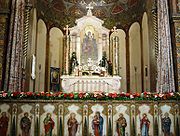 |
Altar cross | A cross on a flat base to rest upon the altar Altar An altar is any structure upon which offerings such as sacrifices are made for religious purposes. Altars are usually found at shrines, and they can be located in temples, churches and other places of worship... of a church. The earliest known representation of an altar cross appears in a miniature in a 9th-century manuscript. By the 10th century such crosses were in common use, but the earliest extant altar cross is a 12th-century one in the Great Lavra Great Lavra This is the monastery on Mount Athos. For the monastery associated with Saint Sabbas, see Mar Saba.The Monastery of Great Lavra is the first monastery built on Mount Athos. It is located on the southeastern foot of the Mount at an elevation of 160 metres... on Mt. Athos. Mass Mass (liturgy) "Mass" is one of the names by which the sacrament of the Eucharist is called in the Roman Catholic Church: others are "Eucharist", the "Lord's Supper", the "Breaking of Bread", the "Eucharistic assembly ", the "memorial of the Lord's Passion and Resurrection", the "Holy Sacrifice", the "Holy and... in the Roman Rite Roman Rite The Roman Rite is the liturgical rite used in the Diocese of Rome in the Catholic Church. It is by far the most widespread of the Latin liturgical rites used within the Western or Latin autonomous particular Church, the particular Church that itself is also called the Latin Rite, and that is one of... requires the presence of a cross (more exactly, a crucifix) "on or close to" the altar. Accordingly, the required cross may rest on the reredos Reredos thumb|300px|right|An altar and reredos from [[St. Josaphat's Roman Catholic Church|St. Josaphat Catholic Church]] in [[Detroit]], [[Michigan]]. This would be called a [[retable]] in many other languages and countries.... rather than on the altar, or it may be on the wall behind the altar or be suspended above the altar. |
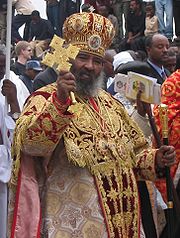 |
Blessing cross Blessing cross A Blessing Cross is a hand cross held by a priest or bishop in Eastern Christianity when he gives a benediction. It is often made of precious metal and may be adorned with enamelwork, and precious or semi-precious gemstones... |
Used by priest Priest A priest is a person authorized to perform the sacred rites of a religion, especially as a mediatory agent between humans and deities. They also have the authority or power to administer religious rites; in particular, rites of sacrifice to, and propitiation of, a deity or deities... s of the Eastern Orthodox and Oriental Orthodox Churches to bestow blessing Blessing A blessing, is the infusion of something with holiness, spiritual redemption, divine will, or one's hope or approval.- Etymology and Germanic paganism :... s upon the faithful. |
| Processional cross Processional Cross A processional cross is a crucifix or cross which is carried in Christian processions. Such crosses have a long history: the Gregorian mission of Saint Augustine of Canterbury to England carried one before them "like a standard", according to Bede. Other sources suggest that all churches were... |
Used to lead religious processions; sometimes, after the procession it is placed behind the altar to serve as an altar cross. | |
| Rood Rood A rood is a cross or crucifix, especially a large one in a church; a large sculpture or sometimes painting of the crucifixion of Jesus.Rood is an archaic word for pole, from Old English rōd "pole", specifically "cross", from Proto-Germanic *rodo, cognate to Old Saxon rōda, Old High German ruoda... |
Large crucifix high in a church; most medieval Western churches had one, often with figures of the Virgin Mary and John the Evangelist John the Evangelist Saint John the Evangelist is the conventional name for the author of the Gospel of John... alongside, and often mounted on a rood screen Rood screen The rood screen is a common feature in late medieval church architecture. It is typically an ornate partition between the chancel and nave, of more or less open tracery constructed of wood, stone, or wrought iron... |
|
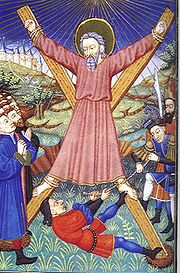 |
Andrew cross Saltire A saltire, or Saint Andrew's Cross, is a heraldic symbol in the form of a diagonal cross or letter ex . Saint Andrew is said to have been martyred on such a cross.... |
See, below, Saltire. |
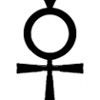 |
Coptic ankh Coptic ankh The Coptic ankh cross, also known as the Gnostic cross, has its origin in the Egyptian Ankh and is the pre Coptic cross of the early Christian gnostic movement.-References:*... |
Shaped like the letter T surmounted by an oval or circle. Originally the Egyptian symbol for "life", it was adopted by the Copts (Egyptian Christians). Also called a crux ansata, meaning "cross with a handle". |
 |
Anthony's cross Anthony's Cross Anthony's Cross is a village in Gloucestershire, England.... |
See, below, Tau cross. |
| Archiepiscopal cross | A double-barred cross carried by an archbishop Archbishop An archbishop is a bishop of higher rank, but not of higher sacramental order above that of the three orders of deacon, priest , and bishop... . |
|
 |
Armenian cross-stone (Khachkar) Armenian Cross An Armenian cross is a symbol that combines a cross with a floral postament or elements. In the Armenian Christianity it was combined with the Christian cross and this design was often used for high crosses – a free-standing cross made of stone and often richly decorated.- External links :* * * * *... |
A khachkar (cross-stone) is a popular symbol of Armenians Armenians Armenian people or Armenians are a nation and ethnic group native to the Armenian Highland.The largest concentration is in Armenia having a nearly-homogeneous population with 97.9% or 3,145,354 being ethnic Armenian.... . |
| Calvary cross | Either a stepped cross (see below), or a Gothic Gothic art Gothic art was a Medieval art movement that developed in France out of Romanesque art in the mid-12th century, led by the concurrent development of Gothic architecture. It spread to all of Western Europe, but took over art more completely north of the Alps, never quite effacing more classical... -style cross mounted on a base shaped to resemble Calvary Calvary Calvary or Golgotha was the site, outside of ancient Jerusalem’s early first century walls, at which the crucifixion of Jesus is said to have occurred. Calvary and Golgotha are the English names for the site used in Western Christianity... (the place where Christ was crucified, pictured as a hill), with the Virgin Mary and Saint John John the Evangelist Saint John the Evangelist is the conventional name for the author of the Gospel of John... on either the base or crossarms. |
|
| Canterbury cross Canterbury cross The Canterbury Cross is one of the crosses that are used to symbolise the Christian faith. It is so called because it was designed after a Saxon brooch, dating ca... |
A cross with four arms of equal length which widen to a hammer shape at the outside ends. Each arm has a triangular panel inscribed in a triquetra (three-cornered knot) pattern. There is a small square panel in the center of the cross. A symbol of the Anglican and Episcopal Anglican Communion The Anglican Communion is an international association of national and regional Anglican churches in full communion with the Church of England and specifically with its principal primate, the Archbishop of Canterbury... Churches. |
|
| Celtic Cross Celtic cross A Celtic cross is a symbol that combines a cross with a ring surrounding the intersection. In the Celtic Christian world it was combined with the Christian cross and this design was often used for high crosses – a free-standing cross made of stone and often richly decorated... |
Essentially a Latin cross, with a circle enclosing the intersection of the upright and crossbar, as in the standing High cross High cross A high cross or standing cross is a free-standing Christian cross made of stone and often richly decorated. There was a unique Early Medieval tradition in Ireland and Britain of raising large sculpted stone crosses, usually outdoors... es. |
|
| Consecration cross | One of 12 crosses painted on the walls of a church to mark where it had been anointed during its consecration Consecration Consecration is the solemn dedication to a special purpose or service, usually religious. The word "consecration" literally means "to associate with the sacred". Persons, places, or things can be consecrated, and the term is used in various ways by different groups... . |
|
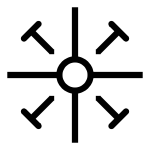 |
Coptic cross Coptic cross The original Coptic cross may have been influenced from the Coptic ankh symbol and was adopted by early Christian Gnostics, most notably Valentinus of Alexandria, Egypt. Today's cross has many different forms. The circle represents the eternal and everlasting love of God. Christ's halo was commonly... |
The original Coptic cross has its origin in the Coptic ankh Coptic ankh The Coptic ankh cross, also known as the Gnostic cross, has its origin in the Egyptian Ankh and is the pre Coptic cross of the early Christian gnostic movement.-References:*... . |
| New Coptic Cross Coptic cross The original Coptic cross may have been influenced from the Coptic ankh symbol and was adopted by early Christian Gnostics, most notably Valentinus of Alexandria, Egypt. Today's cross has many different forms. The circle represents the eternal and everlasting love of God. Christ's halo was commonly... |
This new Coptic Cross Coptic cross The original Coptic cross may have been influenced from the Coptic ankh symbol and was adopted by early Christian Gnostics, most notably Valentinus of Alexandria, Egypt. Today's cross has many different forms. The circle represents the eternal and everlasting love of God. Christ's halo was commonly... is the cross currently used by the Coptic Catholic Church Coptic Catholic Church The Coptic Catholic Church is an Alexandrian Rite particular Church in full communion with the Pope of Rome. Historically, Coptic Catholics represent a schism from the Coptic Orthodox Church, leaving that church in order to come into full communion with the Bishop of Rome.The current Coptic... and the Coptic Orthodox Church of Alexandria. It evolved from the older Coptic Crosses depicted above. A gallery of Coptic Crosses can be found here. |
|
| Cross crosslet | This heraldic cross is made from four Latin Crosses arranged at right-angles to each other, with their tops pointing north, south, east and west, traditionally thought to represent the message of the cross going out to the four corners of the earth. The Cross crosslet, like the Jerusalem Cross Jerusalem cross The Jerusalem cross, also known as Crusaders' cross, is a heraldic cross or Christian symbol consisting of a large Greek cross surrounded by four smaller Greek crosses, one in each quadrant.... , is a symbol for world evangelism Evangelism Evangelism refers to the practice of relaying information about a particular set of beliefs to others who do not hold those beliefs. The term is often used in reference to Christianity.... of the Gospels, which gives an alternative name: Mission Cross. Another common interpretation is that it represents the four evangelists: Matthew, Mark, Luke and John Four Evangelists In Christian tradition the Four Evangelists are Matthew, Mark, Luke, and John, the authors attributed with the creation of the four Gospel accounts in the New Testament that bear the following titles:*Gospel according to Matthew*Gospel according to Mark... . |
|
 |
Crucifix Crucifix A crucifix is an independent image of Jesus on the cross with a representation of Jesus' body, referred to in English as the corpus , as distinct from a cross with no body.... |
A cross with a representation of Jesus Jesus Jesus of Nazareth , commonly referred to as Jesus Christ or simply as Jesus or Christ, is the central figure of Christianity... ' body hanging from it. It is primarily used in Catholic, Anglican, Lutheran, and Eastern Orthodox churches (where the figure is painted), and it emphasizes Christ's sacrifice— his death by crucifixion Crucifixion Crucifixion is an ancient method of painful execution in which the condemned person is tied or nailed to a large wooden cross and left to hang until dead... . |
| Crux fourchette Fork As a piece of cutlery or kitchenware, a fork is a tool consisting of a handle with several narrow tines on one end. The fork, as an eating utensil, has been a feature primarily of the West, whereas in East Asia chopsticks have been more prevalent... |
A cross with flared or forked ends (see illustration at Crosses in Heraldry). | |
| Crux gemmata Crux Gemmata A crux gemmata is a form of cross typical of Early Christian and Early Medieval art, where the cross, or at least its front side, is principally decorated with jewels... |
A cross inlaid with gems. Denotes a glorification of the cross, this form was inspired by the cult of the cross that arose after Saint Helena Helena of Constantinople Saint Helena also known as Saint Helen, Helena Augusta or Helena of Constantinople was the consort of Emperor Constantius, and the mother of Emperor Constantine I... 's discovery of the true cross True Cross The True Cross is the name for physical remnants which, by a Christian tradition, are believed to be from the cross upon which Jesus was crucified.According to post-Nicene historians, Socrates Scholasticus and others, the Empress Helena The True Cross is the name for physical remnants which, by a... in Jerusalem in 327. |
|
| Crux hasta Hasta (spear) Hasta is a Latin word meaning spear. Hastae were carried by early Roman Legionaries, in particular they were carried by and gave their name to those Roman soldiers known as Hastati... |
A cross with a long descending arm; a cross-staff. | |
| Crux pattée Cross pattée A cross pattée is a type of cross which has arms narrow at the centre, and broader at the perimeter. An early English example from the start of the age of heraldry proper A cross pattée (or "cross patty", known also as "cross formée/formy") is a type of cross which has arms narrow at the... |
A Greek cross with flared ends. | |
| Double cross Patriarchal cross The Patriarchal cross is a variant of the Christian cross, the religious symbol of Christianity. Similar to the familiar Latin cross, the Patriarchal cross possesses a smaller crossbar placed above the main one, so that both crossbars are near the top. Sometimes the patriarchal cross has a short,... . |
A cross with two crossbars. See Patriarchal cross. | |
| Globus cruciger Globus cruciger The globus cruciger is an orb topped with a cross , a Christian symbol of authority used throughout the Middle Ages and even today on coins, iconography and royal regalia... |
Globe cross. An orb surmounted by a cross; used in royal regalia. | |
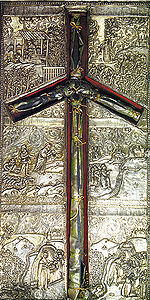 |
Grapevine cross Grapevine cross The Grapevine Cross also known as the Georgian cross or Saint Nino's cross, is a major symbol of the Georgian Orthodox Church, dating from the 4th century AD, when Christianity became an official religion in the kingdom of Iberia .It is recognisable by the slight drooping of its horizontal arms... |
Also known as the cross of Saint Nino of Cappadocia Saint Nino Saint Nino , ), Equal to the Apostles in and the Enlightener of Georgia, was a woman who preached Christianity in Georgia.... , who christianised Georgia Kingdom of Georgia The Kingdom of Georgia was a medieval monarchy established in AD 978 by Bagrat III.It flourished during the 11th and 12th centuries, the so-called "golden age" of the history of Georgia. It fell to the Mongol invasions of the 13th century, but managed to re-assert sovereignty by 1327... . |
 |
Greek cross | With arms of equal length. One of the most common Christian forms, in common use by the 4th century. |
 |
Gnostic cross Sun cross The sun cross, also known as the wheel cross, Odin's cross, or Woden's cross, a cross inside a circle, is a common symbol in artifacts of the Americas and Prehistoric Europe, particularly during the Neolithic to Bronze Age periods.-Stone Age:... |
Cross used by the early Gnostic sects. |
| Jerusalem Cross Jerusalem cross The Jerusalem cross, also known as Crusaders' cross, is a heraldic cross or Christian symbol consisting of a large Greek cross surrounded by four smaller Greek crosses, one in each quadrant.... |
Also known as the Crusader's Cross. A large cross with a smaller cross in each of its angles. It was used as a symbol of the Crusaders who fought against the Islamic forces. | |
 |
Latin cross | Cross with a longer descending arm. Along with the Greek cross, it is the most common form. It represents the cross of Jesus' crucifixion. |
| Living cross | One of two possibilities: Either a natural cross made of living vines and branches. Or, a man-made cross with vines or plants planted at its base. In the all-natural version, it refers to the legend that Jesus' cross was made from the Tree of life. In the man-made cross with plants planted at the base, it contrasts the "new" Tree of Life (the cross) with the Book of Genesis Tree of Life. In both cases it shows Jesus' death (the cross) as a redemption for original sin (Tree of Life). | |
 |
Lorraine cross Cross of Lorraine The Cross of Lorraine is originally a heraldic cross. The two-barred cross consists of a vertical line crossed by two smaller horizontal bars. In the ancient version, both bars were of the same length. In 20th century use it is "graded" with the upper bar being the shortest... |
Once with crossbars of equal length near the top and the bottom, now practically identical with the patriarchal cross |
 |
Maltese cross Maltese cross The Maltese cross, also known as the Amalfi cross, is identified as the symbol of an order of Christian warriors known as the Knights Hospitaller or Knights of Malta and through them came to be identified with the Mediterranean island of Malta and is one of the National symbols of Malta... |
A Greek cross with arms that taper into the center. The outer ends may be forked. |
| Marian Cross Marian Cross The Marian Cross is an informal name applied to a Roman Catholic cross design. It consists of a traditional Latin cross with the crossbar extended on the right, and a letter "M" in the lower right quadrant.... |
A term invented to refer to Pope John Paul II Pope John Paul II Blessed Pope John Paul II , born Karol Józef Wojtyła , reigned as Pope of the Catholic Church and Sovereign of Vatican City from 16 October 1978 until his death on 2 April 2005, at of age. His was the second-longest documented pontificate, which lasted ; only Pope Pius IX ... 's combination of a Latin cross and the letter M, representing the Mary present on Calvary Calvary Calvary or Golgotha was the site, outside of ancient Jerusalem’s early first century walls, at which the crucifixion of Jesus is said to have occurred. Calvary and Golgotha are the English names for the site used in Western Christianity... . |
|
 |
Occitan cross Languedoc Languedoc is a former province of France, now continued in the modern-day régions of Languedoc-Roussillon and Midi-Pyrénées in the south of France, and whose capital city was Toulouse, now in Midi-Pyrénées. It had an area of approximately 42,700 km² .-Geographical Extent:The traditional... |
Based on the counts of Toulouse Toulouse Toulouse is a city in the Haute-Garonne department in southwestern FranceIt lies on the banks of the River Garonne, 590 km away from Paris and half-way between the Atlantic Ocean and the Mediterranean Sea... 's traditional coat of arms, it soon became the symbol of Occitania Occitania Occitania , also sometimes lo País d'Òc, "the Oc Country"), is the region in southern Europe where Occitan was historically the main language spoken, and where it is sometimes still used, for the most part as a second language... as a whole. |
| Papal Cross Papal Cross The papal cross or ferula is the pastoral staff used by the Pope. This is in contrast to other bishops, who use a crozier.The pastoral staff carried by the popes since Pope Paul VI is a contemporary single-barred cross, designed by the Italian artist Lello Scorzelli and carried in the same manner... |
A cross with three bars near the top. The bar are of unequal length, each one shorter than the one below. | |
| Patriarchal cross Patriarchal cross The Patriarchal cross is a variant of the Christian cross, the religious symbol of Christianity. Similar to the familiar Latin cross, the Patriarchal cross possesses a smaller crossbar placed above the main one, so that both crossbars are near the top. Sometimes the patriarchal cross has a short,... |
Also called an archiepiscopal cross or a crux gemina. A double cross, with the two crossbars near the top. The upper one is shorter, representing the plaque nailed to Jesus' cross. Similar to the Cross of Lorraine Cross of Lorraine The Cross of Lorraine is originally a heraldic cross. The two-barred cross consists of a vertical line crossed by two smaller horizontal bars. In the ancient version, both bars were of the same length. In 20th century use it is "graded" with the upper bar being the shortest... , though in the original version of the latter, the bottom arm is lower. The Eastern Orthodox cross adds a slanted bar near the foot. |
|
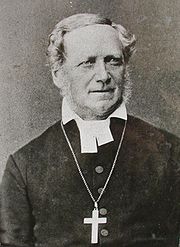 |
Pectoral cross Pectoral cross A pectoral cross or pectorale is a cross, usually relatively large, suspended from the neck by a cord or chain that reaches well down the chest. It is worn by the clergy as an indication of their position, and is different from the small crosses worn on necklaces by many Christians, which have no... |
A large cross worn in front of the chest (in Latin Latin Latin is an Italic language originally spoken in Latium and Ancient Rome. It, along with most European languages, is a descendant of the ancient Proto-Indo-European language. Although it is considered a dead language, a number of scholars and members of the Christian clergy speak it fluently, and... , pectus) by some clergy Clergy Clergy is the generic term used to describe the formal religious leadership within a given religion. A clergyman, churchman or cleric is a member of the clergy, especially one who is a priest, preacher, pastor, or other religious professional.... . |
 |
Peter cross Cross of St. Peter The Cross of St. Peter or Petrine Cross is an inverted Latin cross traditionally used as a Christian symbol, but in recent times also used widely as an anti-Christ symbol .-In Christianity:The origin of this symbol comes from the Catholic tradition that Simon Peter was crucified upside... |
A cross with the crossbeam placed near the foot, that is associated with Saint Peter Saint Peter Saint Peter or Simon Peter was an early Christian leader, who is featured prominently in the New Testament Gospels and the Acts of the Apostles. The son of John or of Jonah and from the village of Bethsaida in the province of Galilee, his brother Andrew was also an apostle... because of the tradition that he was crucified head down. |
| Rose Cross | A cross with a rose blooming at the center. The central symbol to all groups embracing the Esoteric Christian philosophy of the Rosicrucians. | |
 |
Russian Russian Orthodox Church The Russian Orthodox Church or, alternatively, the Moscow Patriarchate The ROC is often said to be the largest of the Eastern Orthodox churches in the world; including all the autocephalous churches under its umbrella, its adherents number over 150 million worldwide—about half of the 300 million... Orthodox cross Orthodox cross The Orthodox Cross is a variation of the Christian cross and is commonly found in Eastern Orthodox Churches. The cross has three horizontal crossbeams, the top representing the plate with INRI, and the bottom, a footrest... |
(See Suppedaneum cross, below). |
| Saltire Saltire A saltire, or Saint Andrew's Cross, is a heraldic symbol in the form of a diagonal cross or letter ex . Saint Andrew is said to have been martyred on such a cross.... or crux decussata |
An X-shaped cross associated with St. Andrew, patron of Scotland Scotland Scotland is a country that is part of the United Kingdom. Occupying the northern third of the island of Great Britain, it shares a border with England to the south and is bounded by the North Sea to the east, the Atlantic Ocean to the north and west, and the North Channel and Irish Sea to the... , and so a national symbol of that country. The shape is that of the cross on which Saint Andrew Saint Andrew Saint Andrew , called in the Orthodox tradition Prōtoklētos, or the First-called, is a Christian Apostle and the brother of Saint Peter. The name "Andrew" , like other Greek names, appears to have been common among the Jews from the 3rd or 2nd century BC. No Hebrew or Aramaic name is recorded for him... is said to have been martyred. Also known as St. Andrew's Cross or Andrew Cross. |
|
| Stepped cross | A cross resting on a base with three steps, also called a graded or a Calvary cross. | |
 |
Suppedaneum cross Orthodox cross The Orthodox Cross is a variation of the Christian cross and is commonly found in Eastern Orthodox Churches. The cross has three horizontal crossbeams, the top representing the plate with INRI, and the bottom, a footrest... |
Also known as Crux Orthodoxa, Byzantine cross, Eastern cross, Russian cross, Slavic or Slavonic cross. A three-barred cross in which the short top bar represents the inscription over Jesus' head, and the lowest (usually slanting) short bar, placed near the foot, represents his footrest (in Latin, suppedaneum). This cross existed very early in Byzantium Byzantium Byzantium was an ancient Greek city, founded by Greek colonists from Megara in 667 BC and named after their king Byzas . The name Byzantium is a Latinization of the original name Byzantion... , and was adopted by the Russian Orthodox Church and especially popularized in the Slavic countries. |
| Saint Thomas Cross St Thomas Cross The St. Thomas Cross, also known as the Mar Thoma Sliva, is the symbol of the Nazrani people. There are six branches of the cross representing the appearance of God in the burning bush, while the central branch holds the cross, and the dove at the tip of the cross represents the Holy Spirit.... |
The ancient cross used by the Syrian Malabar Nasrani Syrian Malabar Nasrani The Syrian Malabar Nasrani people, also known as Saint Thomas Christians, "'Nasrani Mappila'" and Nasranis, are an ethnoreligious group from Kerala, India, adhering to the various churches of the Saint Thomas Christian tradition... community of Saint Thomas Christians Saint Thomas Christians The Saint Thomas Christians are an ancient body of Christians from Kerala, India, who trace their origins to the evangelical activity of Thomas the Apostle in the 1st century. They are also known as "Nasranis" because they are followers of "Jesus of Nazareth". The term "Nasrani" is still used by St... in Kerala, India. |
|
 |
Tau cross Cross of Tau The Cross of Tau, named after the Greek letter it resembles, is suspected to have originated with the Egyptians. When a King was initiatied into the Egyptian mysteries a tau was placed against his lips. It has been a symbol to many cultures before Christianity, including a mention in the Old... |
A T-shaped cross. Also called the Saint Anthony Anthony the Great Anthony the Great or Antony the Great , , also known as Saint Anthony, Anthony the Abbot, Anthony of Egypt, Anthony of the Desert, Anthony the Anchorite, Abba Antonius , and Father of All Monks, was a Christian saint from Egypt, a prominent leader among the Desert Fathers... 's cross and crux commissa. |
For further information on the forms in which the cross is represented, including its heraldric
Heraldry
Heraldry is the profession, study, or art of creating, granting, and blazoning arms and ruling on questions of rank or protocol, as exercised by an officer of arms. Heraldry comes from Anglo-Norman herald, from the Germanic compound harja-waldaz, "army commander"...
use, see the article Cross
Cross
A cross is a geometrical figure consisting of two lines or bars perpendicular to each other, dividing one or two of the lines in half. The lines usually run vertically and horizontally; if they run obliquely, the design is technically termed a saltire, although the arms of a saltire need not meet...
.
Unicode contains a number of cross symbols
Cultural, political, and religious symbols in Unicode
Unicode contains many characters that represent various cultural, political, and religious symbols. Many but not all of these are in the Miscellaneous Symbols block....
. The dagger
Dagger (typography)
A dagger, or obelisk. is a typographical symbol or glyph. The term "obelisk" derives from Greek , which means "little obelus"; from meaning "roasting spit"...
symbol also represents the Christian cross. In Unicode
Unicode
Unicode is a computing industry standard for the consistent encoding, representation and handling of text expressed in most of the world's writing systems...
, it is U+2020().
See also
- Christian symbolismChristian symbolismChristian symbolism invests objects or actions with an inner meaning expressing Christian ideas. Christianity has borrowed from the common stock of significant symbols known to most periods and to all regions of the world. Religious symbolism is effective when it appeals to both the intellect and...
- Cross burningCross burningCross burning or cross lighting is a practice widely associated with the Ku Klux Klan, although the historical practice long predates the Klan's inception...
- Cross of All NationsCross of All NationsThe Cross of All Nations is a monumental cross located in Qanat Bakish, a locality close to the Lebanese town of Baskinta. The cross was built near a church dating back to 1898 on a land belonging to the Lebanese Maronite Order...
- Dispute about Jesus' execution methodDispute about Jesus' execution methodJehovah's Witnesses teach that Jesus died on an upright pole: "The Gospel accounts of Matthew, Mark, Luke, and John use the Greek word stau·ros′ when referring to the instrument of execution on which Jesus died...
- Intending crossIntending crossA memorial cross is a cross, which was built as memorial to commemorate a special event; or it may be a simple form of headstone to commemorate the dead.-See also:*Eleanor cross*Roadside memorial*High cross...
- KhachkarKhachkarA khachkar or khatchkar is a carved, cross-bearing, memorial stele covered with rosettes and other botanical motifs. Khachkars are characteristic of Medieval Christian Armenian art found in Armenia.-Description:...
- Market crossMarket crossA market cross is a structure used to mark a market square in market towns, originally from the distinctive tradition in Early Medieval Insular art of free-standing stone standing or high crosses, often elaborately carved, which goes back to the 7th century. Market crosses can be found in most...
- Rood screenRood screenThe rood screen is a common feature in late medieval church architecture. It is typically an ornate partition between the chancel and nave, of more or less open tracery constructed of wood, stone, or wrought iron...
- Rood loft
- RoodmasRoodmasRoodmas , held on May 3, was the celebration of the Feast of the Cross observed in some Christian churches and rites, particularly the historical Gallican Rite of the Catholic Church. It commemorates the finding by Saint Helena of the True Cross in Jerusalem in 355...
- StaurosStaurosStauros is the Greek word, usually translated cross, that in the Bible is used in reference to the device on which Jesus was executed...
External links
- MSN Encarta (Archived 2009-10-31), "Cross"
- Philip SchaffPhilip SchaffPhilip Schaff , was a Swiss-born, German-educated Protestant theologian and a historian of the Christian church, who, after his education, lived and taught in the United States.-Biography:...
, History of the Christian Church, Ch. 6th, "Christian Art: § 77. The Cross and the Crucifix" - An Explanation of the Russian Orthodox Three-Bar Cross
- Variations of Crosses - Images and Meanings

